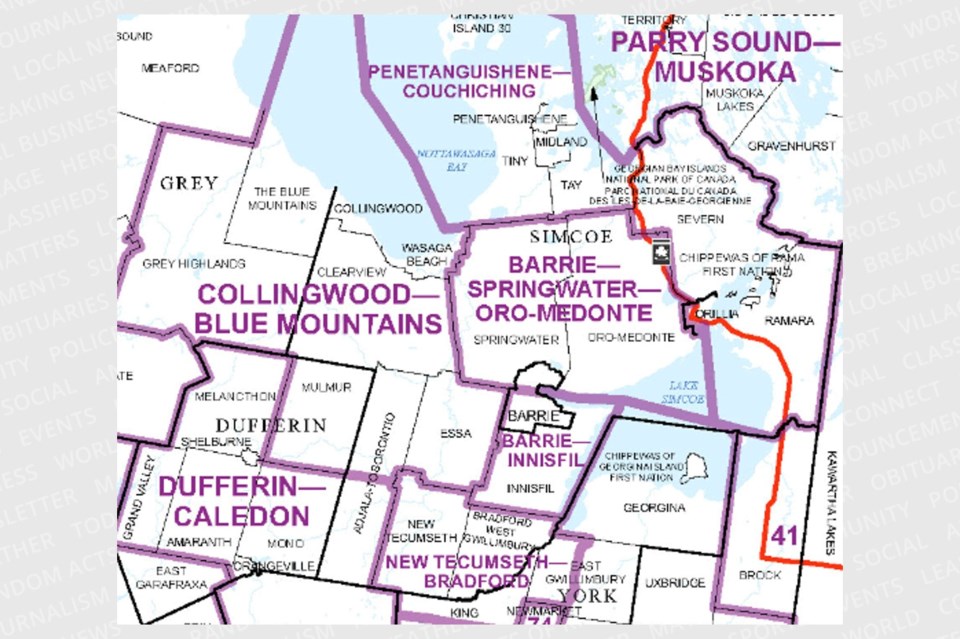A proposal to change the names of two Barrie ridings is being supported by the Federal Electoral Boundaries Commission.
In its final report delivered Friday, the commission said under the plan, Barrie-Innisfil has been renamed Barrie South-Innisfil, while Barrie-Springwater-Oro-Medonte becomes Barrie North-Springwater-Oro-Medonte.
The commission also proposed a small adjustment be made between Simcoe North and Barrie-Springwater-Oro-Medonte, aligning the boundary with the Township of Oro-Medonte’s municipal limits.
In September, Simcoe North MP Adam Chambers encouraged those not enthused about the proposed riding name change to speak up as the commission considered the public’s response to its initial plans during hearings throughout the fall.
At the time, Chambers said it was odd the commission was even considering the name change given Simcoe North’s status as one of the few ridings existing today that was created as part of 1867's British North America Act.
“What’s the purpose of the name change?” said Chambers, who was in favour of maintaining the Simcoe North name. “Is John Graves Simcoe a person we’re no longer honouring?”
Of course, Chambers notes that at the time the riding looked much different than it does nowadays.
Upon its creation in 1867, the riding included the townships of Nottawasaga, Sunnidale, Vespra, Flos, Oro, Medonte, Orillia and Matchedash, Tiny and Tay, Balaklava and Robinson, and the Towns of Barrie and Collingwood.
Meanwhile, the Simcoe North moniker isn’t going anywhere.
A proposal to change the name of the long-time federal riding to Penetanguishene-Couchiching won’t be adopted by the commission after all.
It noted that while there was some support for the proposed name change “as a symbol of reconciliation,” it received many submissions regarding the commission’s choice of name.
“It was noted that the name did not reference the largest current Indigenous communities in the district,” the commission noted in its report.
“Further, there were extensive submissions emphasizing the historic nature of the original name, Simcoe North, which has been used since Confederation. The Commission concluded that the historic name of Simcoe North should be retained for this district.”
The commission comes together every 10 years to take a closer look at the country’s ridings to ensure numbers of residents are more or less equal across each province.
Under the plan, the commission set out to draw 122 electoral districts in Ontario with an eye to achieving voter parity throughout the province “as much as reasonably possible.” as mandated by the Electoral Boundaries Readjustment Act.
According to the “independent, impartial and non-partisan” commission, it tried to meet a pre-set population quota of 116,590 residents per riding. According to the 2021 census, Ontario’s population sat at 14,223,942.
According to the commission, the population of Central Ontario, which includes Simcoe North, grew by 17.9 per cent, from 625,530 in 2011 to 737,495 in 2021. The remainder of Ontario grew by 10.3 per cent in the same period.
The existing six electoral districts in central Ontario have an average 2021 population of 122,916 and fall 5.4 per cent above the quota.
While British Columbia, Alberta and Quebec have similar quotas to Ontario, in other provinces it is significantly lower. As an example, Prince Edward Island has a quota of just 38,583 residents per riding.
“Historical patterns, communities of interest and identity, and manageable geographic size for districts in sparsely populated, rural or northern regions of the province were also considered,” the commission noted in the report.
It also had the responsibility of creating one additional electoral district, given that Ontario had been allocated 122 seats.
“The Commission concluded that the effect of uneven population shifts across the province, with significant growth in some areas and only modest growth in others over the past decade, required adjustments to many existing district boundaries in order to address patterns of voter under-representation and over-representation,” the report stated.
“In creating our proposal for a redistribution plan, the Commission endeavoured to limit the deviation from the quota to no more than plus or minus 10 per cent.”
The commission also considered First Nations communities and the interests of Franco-Ontarians in drawing these boundaries.



